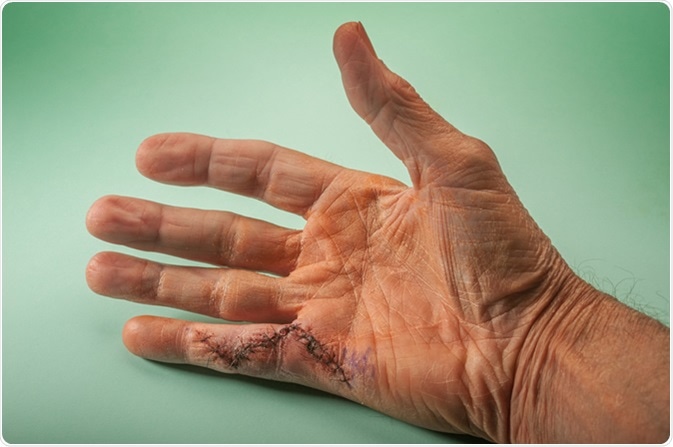Dupuytren’s contracture is a progressive condition that impacts the fingers and the hands, causing at least one finger, and possibly several, to bend toward the palm of the hand. Essentially, connective tissue in the palm of the hand becomes thicker. Also known as Dupuytren's disease, the condition can affect both hands, including the thumbs. It is not life-threatening, although it can be discomforting.

Results of hand surgery for Dupuytren's disease. Image Credit: Christian Delbert / Shutterstock
Causes
While the exact cause of Dupuytren’s contracture is not known, genetics and ancestry may have an influence. But it is known that an injury or extensive use of the hand does not lead to Dupuytren’s. The scientific community believes the condition can run in families. Several factors put people at extended risk:
- The condition is believed to be inherited.
- It is more common in those of northern European descent, such as the English, Irish, Scottish, French, or the Scandinavians.
- It may be associated with consuming alcohol or smoking.
- Certain medical conditions, including diabetes, may cause its onset.
- It may be related to having undergone a seizure.
- It occurs more often as people age, notably over the age of 40 years.
- It more often occurs in men.
Outward Signs
It is possible to differentiate Dupuytren's disease from other causes of muscle and tissue hardening of the hand since it initiates as a nodule, or lump, and slowly progresses to contracture of the palm and fingers. Most often, changes involve a swelling of skin cells – the nodules, which are not cancerous. However, some lumps may not be the nodules associated with Dupuytren’s. They might be warts, cysts, blisters, or tumors. Certain lumps could be a type of hard scar tissue in the top layer of skin, not under it, which is where Dupuytren’s nodules occur.
When a patient visits a doctor regarding the condition, the doctor should make note of the location of the nodule, and if any hardening and contractures exist, along with pitting of the skin and tenderness. The pitting that occurs makes the skin appear as if it had been contracted in toward the center, or the palm, of the hand, with the appearance of a dimple. Pitting often takes place after the nodules appear, but may also occur without nodules.
Sometimes, the condition also impacts the fingers. The shortening and hardening of muscles and tissue -- contracture -- usually causes deformity and rigidity of joints to set it. The disease can be painful to some, but not to everyone who has it. Some also may experience burning or itching.
Contracting Cords
Cords existing between the deep fascia in the hand and the top layer of skin do the actual contracting. The cords often will extend from nodules. However, sometimes they appear without the existence of a nodule. These cords are stringy and are located above the bones and under the skin. They pull the finger toward the hand’s center when contracting.
The cords could run along the length of the finger tendons toward the base of the center of the hand. They may initiate in the finger and eventually grow towards the center of the hand. Or the cords may not grow at all outside of a finger. They are hard to touch and can be felt just under the skin. In many cases, the cords can be felt, by pressing slightly on the palm, before they are visible to the eye.
Or initially, the cords may appear in the area at the bottom of a finger or in the middle of the hand’s palm. Eventually, as these cords grow in size, they can extend from the base of one finger to the base of the palm. Moreover, it is possible that cords emanating from different fingers may eventually connect with each other in the center of the hand.
Yet, some people who have nodules and cords may never develop a contracture. In others, the cords could initiate a contracture, but not immediately, instead only after a few months or years. The impacted fingers may not straighten completely again. This makes it difficult to do such simple actions as placing one’s hands in one’s pockets or wearing gloves comfortably. Even the simplest handshake is challenging.
Further Reading